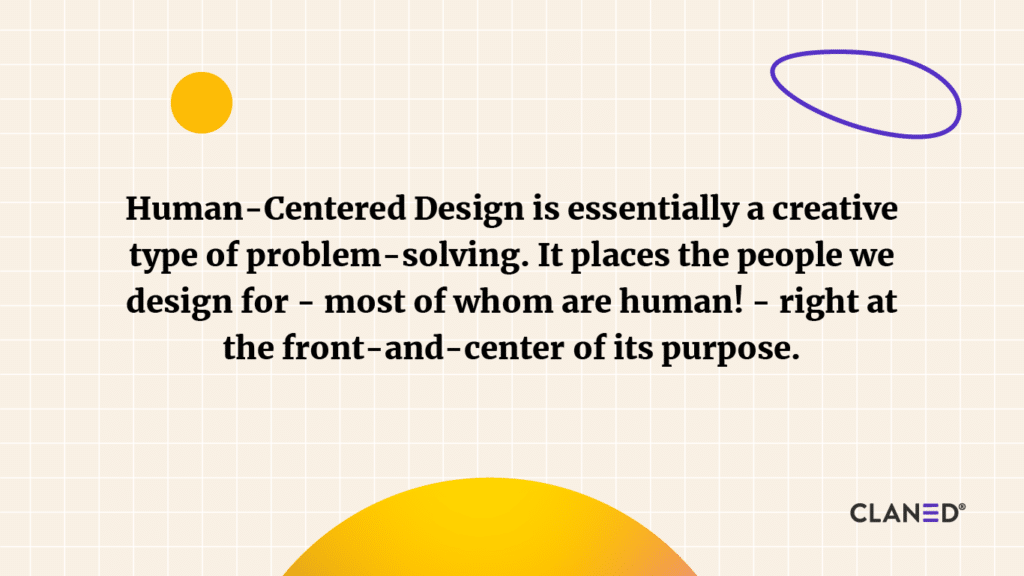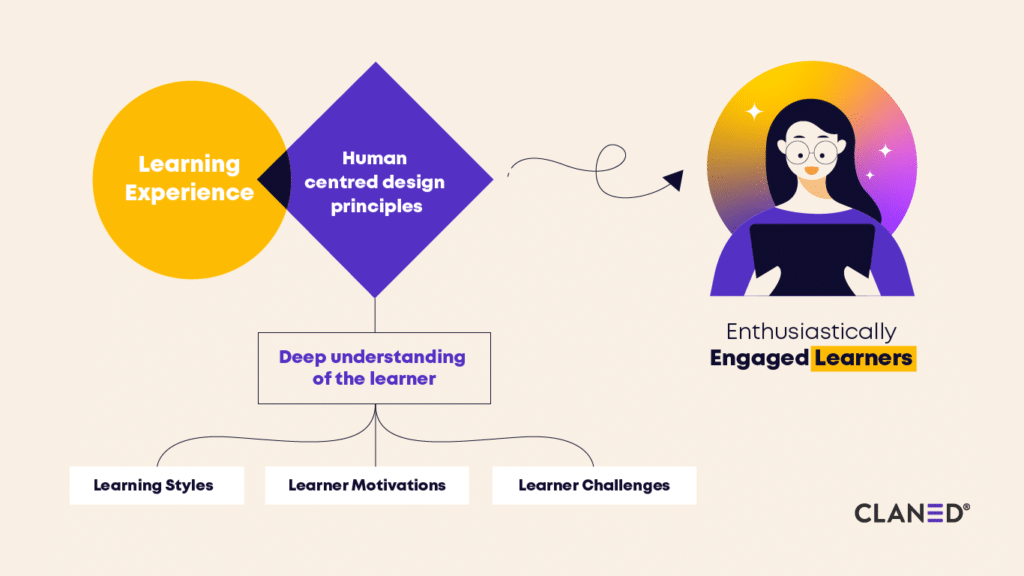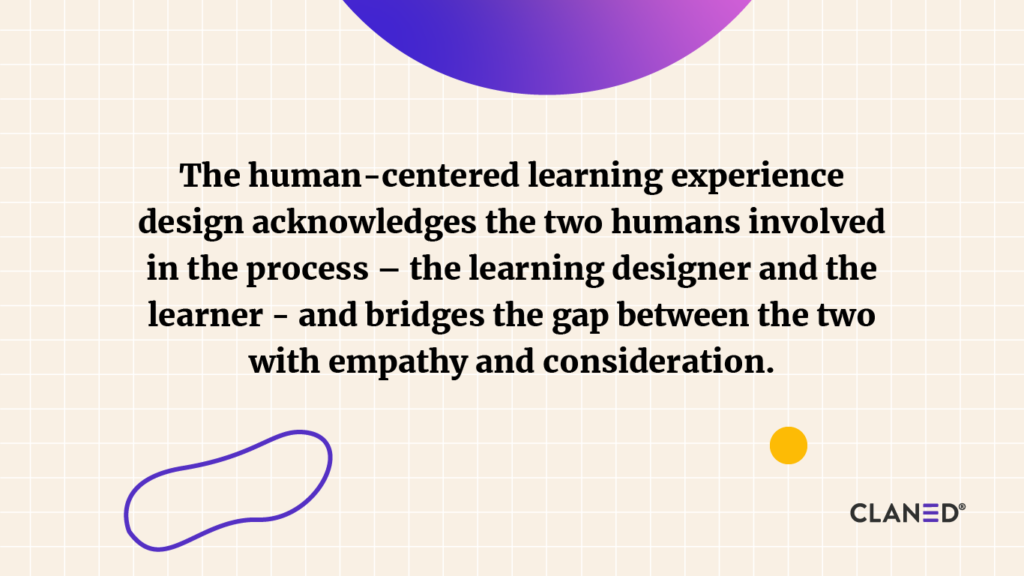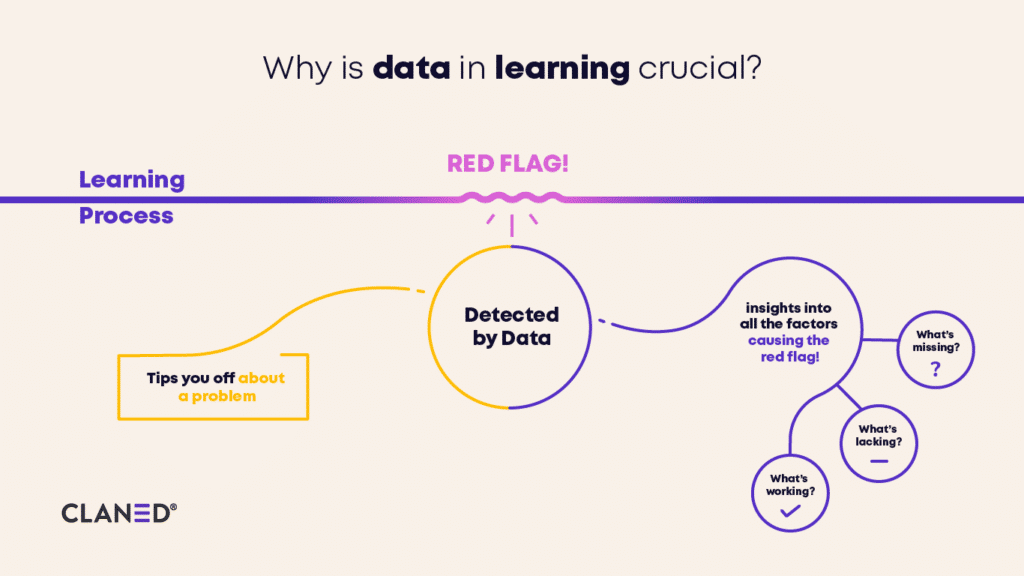Introduction
You’ve heard that sage L&D advice that tells you what good learning programs are made of. It’s a decades-old recipe that includes things like rigorous planning, a singular focus on business objectives, clear targets for learners all that good stuff. But does it include a Human-Centered Design?
And yet, when the actual program begins, all you see are yawns, lethargy, and glazed-over eyes. In the worst case, you find a bunch of learners who’ve read a lot, answered a lot of questions, but have taken nothing tangible away to apply to a real-life context.
So, what happened? What went wrong?
Well, to start with, you are not alone. Many organizations build their learning programs and products off of the back of this recipe that continues to yield unengaged, unmotivated learners across the board.
But the truth is that this classic recipe has always missed an essential ingredient – the humans that it’s cooking up the learning program for! Somewhere amidst all the talk of business goals, outcomes and jargon, our learning programs have lost sight of the learner and what makes them tick.
Here at Claned, though, we do things a little differently. Our learning program recipes include a secret ingredient called Human-Centered Design, and it delivers exactly what it says on the packet. A form of product design that is centered around human learners and gets its value directly from insights into human nature.
But we’re not the only fans of this secret ingredient. That’s why we sat down for a chat with April Reissmann, a fellow Human-Centered Design lover and program designer, to talk about this exciting approach to learning and its many benefits.
Who is April Reissmann?
Say hello to April Reissmann, a Learning and Development Human-Centered Program Designer. “That’s about all of my words in the right order”, she chuckles.
April believes in helping people work better so they can live better. Whether it be building a certain set of skills, or learning a new tool for work, she is an expert at designing programs that are learner-centric and tailored to meet specific needs. She has developed a variety of learning programs for clients and employers across the world including Opal, KinderCare Education, R2 Group, and 4G Clinical.
Her work philosophy, in her own words, is: “Most of us have signed to the thought of “we have to work for a living”. So my idea is why not make that work a little more enjoyable, a bit more fun and a bit more relaxed”.
And in so many ways, that philosophy is exactly what human-centered design boils down to.
So What Exactly is Human-Centered Design?
Human-Centered Design is essentially a creative type of problem-solving. It places the people we design for – most of whom are human! – right at the front-and-center of its purpose. Before coming up with solutions for a problem, a human-centered designer asks two essential questions:
- What kind of problem are we looking to solve?
- How can we meet the needs and capabilities of the humans we are solving this problem for?
For learning experience designers, human-centered design principles can be the key difference between a bored-out-of-their-minds batch of trainees and a group of enthusiastically engaged learners.

“Traditionally, when we’re problem-solving with learning programs, we tend to focus on the outcome. We apply expertise, get subject matter experts on the task, set learning objectives, and then create the standard ‘course with quizzes’ – job done. But with human-centered design, we start with asking ourselves where the problem lies and why.”
This is where a learning experience designer can really hone in on the problem, dig deep and define it in a way that clarifies the ‘why’ of it all. Why are the learners not engaged? Why does this mode of presenting information not work for them? Why on earth are we making learners go through so much text?
That last question, in particular, represents the other all-important element in human-centered design: empathy. As April explains, “The human-centered designer problem-solves by going through and making sure that the learning material and experience is meeting the learner where they’re at and what makes sense for them”.
At the heart of human-centered design are curiosity and a deep understanding of the learner, their learning styles, motivations, and challenges. And that’s because it has no interest in designing for the designers or the researchers – only for the people at the other end of the learning experience.

So with all that said, what exactly can human-centered design do for learning programs that our good ol’ methods can’t? Before we dive into that, let’s look at the many ways in which a human-centered design approach makes learning a lot more, and we mean a LOT MORE exciting.
Infusing Fun into Learning Experience Design – No, Really!
When someone responds with “fun” to a learning program requirement, chances are they’re being sarcastic. But with human-centered design, you are allowed to take the concept and applicability of fun very, very seriously.
Fun is often viewed as a sign of frivolity and in the context of learning, as a distraction. But research into human learning has shown that positive emotions like fun, enjoyment, and excitement have a direct link to successful adult learning and promote feelings of competence, learner autonomy, and goal achievement.
“When I facilitate trainings, I often get comments like “this was really fun” or “I’ve never laughed so much during a training”, says April. “But the thing is, if I’m training a bored training session, I’m bored too.”
It’s all about “people talking to people”. The human-centered learning experience design acknowledges the two humans involved in the process – the learning designer and the learner – and bridges the gap between the two with empathy and consideration. It encourages designers and facilitators to create a learning experience that is built on human commonalities. The natural outcome is a learning program that is learner-friendly and designed to not just educate but entertain and engage the learner in new ways.

This could be in the form of lively learning materials, gamified elements, casual and conversational training sessions, role-playing activities or multimedia presentation options (in place of long blocks of text that no one likes to go through!).
‘Fun’ isn’t a diversion, it’s a fundamental human value. And it can pump up learners and encourage them to exert their best efforts in an environment that isn’t set on wearing them out. As April says, “At the end of the day, we’re the adults here, we make the rules. Training doesn’t have to be boring. Education doesn’t have to be boring.”
Storytelling and Connecting with Other Humans
Human-centered design also delves deep into the untapped potential of the emotional and social aspects of learning.
You know the way that people’s eyes widen and ears perk up when they hear a great story? That’s the power of emotions in storytelling at play. And it is one that human-centered design recognizes well.
“Storytelling is one of the oldest forms of communication and an effective way to insert humanity into L&D. When the learning program includes a story where the narrative is applicable to the learning material and is told through a character’s eyes, the learner is immediately able to recognize themselves and follow along.”
This need to connect with humans and human experiences is also why learning programs benefit from having an embedded social component. From a human-centered design perspective, social interaction and social feedback are crucial to the learning experience.
“When I learned about Claned and the social aspect of it, that is an absolute example of how we’re able to take the research about how humans interact and learn and then apply it into the educational space”, says April. “We’re social creatures, and this is a great way to apply this unique feature of us as a species, to learning”.
But it gets even better: incorporating social features in your learning programs can also help your learners learn more effectively. Through social interactions with each other, learners are introduced to different perspectives on the same learning material. As a result, their knowledge base widens.
“No two sets of notes look the same. People process the same information differently. That’s why the idea with note-taking is to catch what resonates with you and how it makes sense to you. Then, when you trade notes, you’re able to see how you’ve all interpreted it differently, giving you the opportunity to learn in a different way”, explains April.
Can Data and Human-Centered Design Get Along?
By now you’ve caught our drift: to build an engaging learning experience design, being in touch with the human inside is important. Emotions, social interactions, sentiment, and all that warm stuff are far more essential to the learning process than we might imagine.
But you might also wonder: does the soft skill focus of human-centered design leave any room for cold, hard data?
If you ask April, the answer is an enthusiastic yes. As she explains, “Data in learning is crucial because it often triggers the first red flag and tips you off about a problem. It also offers vital insights into all the factors surrounding the problem – what’s missing, what’s lacking, what’s working. That’s where the humans come in. You then bring in actual people to tell you about their first-hand experiences, share their concerns and offer recommendations.”

And we agree! Data can be the order in the chaos that is the learning experience. When it comes to designing and refining learning programs, the right set of learning analytics about skill levels, engagement levels, and learning impact can make all the difference.
Analytics can also help measure the effectiveness of your learning programs. So if you’ve been having a hard time proving the value of your L&D programs, data can be your absolute best friend. It can show, in clear-as-day numbers, exactly how your L&D programs are aiding the company’s performance and business goals. The results are way too good to miss out on. As many as 40% percent of organizations that measure the success of their L&D programs and initiatives say that they perform at a higher level than their competitors.
What Exactly Sets Human-Centered Design Apart?
As promised, it’s time for the big question: what can human-centered design do for a learning experience that the traditional design approach cannot?
It all ultimately comes down to this: when pitted against run-of-the-mill learning design, human-centered design excels because it acknowledges that it doesn’t know everything. And that’s why it knows to ask the right questions from the right people.
As April explains, “Human-centered design is about reaching out to the actual humans that are going to be learning, and hearing directly from them. This is key information, because it varies from company to company, and doesn’t always translate across cultures, humans, and their needs. They have different experiences and challenges which inform the learning experience and then help improve it for future learners.”
And because human-centered design is focused on providing the best learning experience for its learners, it is also focused on constantly evolving and changing things up based on the input from those learners.
“The human-centered designer is always going to go one step further and break the status quo to think about what makes learning engaging. It’s about seeing how we can try, retry, iterate, prototype and fail-fast to always be creating a better iteration of the learning experience based on analytics and human observations”, April explains.
And you know what the best part of it all is? The designer doesn’t get to be so lonely. That feeling of working on, building, and accomplishing a successful learning program gets to be shared by all humans involved!
“You give them an opportunity to contribute instead of just instructing them. Instead of going “this is how it is and how you have to do it, by golly”, you’re collecting from the community. You’re gathering info on what makes sense, what works, what were their ‘a-ha’ moments – all the nuanced insights that you wouldn’t find anywhere else”, says April.
Finally, from a business perspective, human-centered design just makes good sense. No more wasting time, money, and resources in figuring out the secret sauce for keeping people engaged. The human-centered approach takes out the guesswork from learning experience design and helps companies and employees train, onboard, upskill, and reskill better.
Now, doesn’t that just sound like a much better recipe for learning programs?
The Bottom Line
So here it is: the secret behind the not-so-secret ingredient called Human-Centered Design and why we, April, and L&D designers around the world are such huge fans of it.
There are a lot of processes out there that benefit from focusing on goals, objectives, and milestones. But we here at Claned believe that the process of learning benefits mainly by focusing on the experience of the learner.
We think April put it best when she said: “It’s really about meeting the humans where they’re at. We’re not robots, we’re not machines, we can’t sprint a marathon. This learning design is really about meeting learners where they’re at instead of expecting them to cover an impossible distance to get where you want them to be”.
Want to know how you can incorporate human-centered design in your L&D programs?







